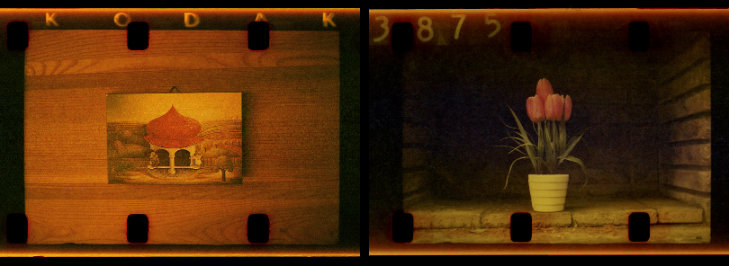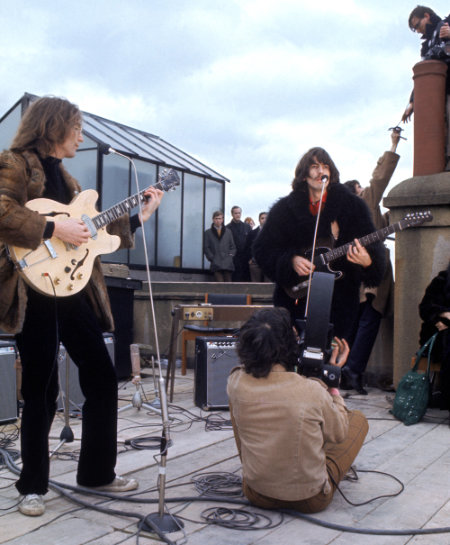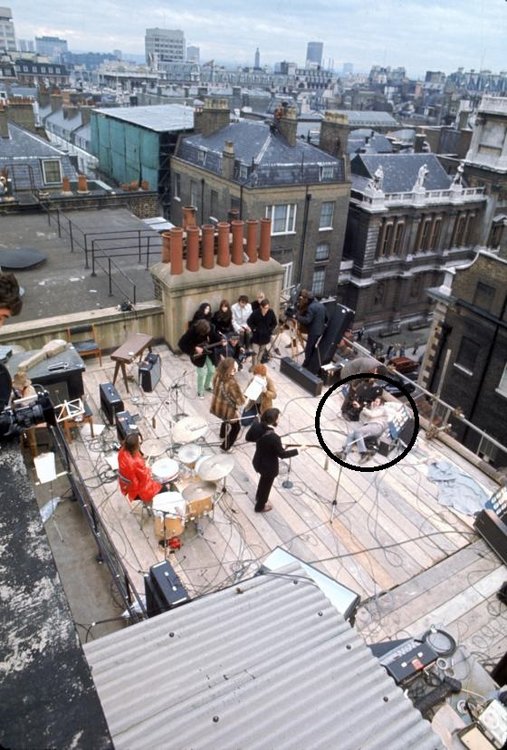-
Posts
88 -
Joined
-
Last visited
Everything posted by Bernhard Kipperer
-

ECN-1 processing steps
Bernhard Kipperer replied to Bernhard Kipperer's topic in Film Stocks & Processing
I loaded some feet of the Eastman Color Negative 7254 16mm film into a 110 cartridge and shot it in a Pentax 110 still camera. Last weekend I used that as a first test to see if I can also develop that film into color (black and white worked out fine last time). See below two examples developed in normal Tetenal C-41 chemistry. I went for 22°C/71F instead of 38°C/100F and 12 mins/12mins for CD and BLIX instead of 3:15min/4:00min. I really like the results. Edge markings show that this roll of film is from 1973! I have already shot much more in the meantime, however with an adapter in a 35mm Canon SLR with better lenses. If you want to see the images in full quality (here the upload size is limited) go to http://photography.filmcurl.com/ -

ECN-1 processing steps
Bernhard Kipperer replied to Bernhard Kipperer's topic in Film Stocks & Processing
I successfully developed the Eastman Color Negative 7254 in Rodinal yesterday! First I prepared two short snippets, each holding a few test frames only, in two separate tanks. I developed the first one for 10 mins at 22° / 71F in Rodinal and used 10 mins of fixing afterwards. It produce images, which was the first great success of the evening, especially for a film that expired in the early 70s, but the negative was very dense. Next I developed the second snippet for only 5 mins, which gave quite nice images, so that's the time I chose for the actual film then too. To get rid of the remjet I used lots of washing soda in some destilled water, filled that in the tank and shook it like crazy for 1 min, then let it rest for anther min before I poured it away. After the fixing I removed the rest with a soft cloth, came off quite fast, much easier than on modern Vision 3 stock. I had taken still images through red, green and blue filters and after scanning I realigned the negs today and got some nice color images. The negs are quite grainy, but I did cross-process then (and even in Rodinal). After looking for some time, I could find the edge marking with the date code symbols. This film is from 1973, so 45 years old, who would have guessed it is still good? The next step will be to try another short piece of the film in C-41, maybe later in ECN-2 and then finally to shoot th rest of it in the Kransnogorsk. -

ECN-1 processing steps
Bernhard Kipperer replied to Bernhard Kipperer's topic in Film Stocks & Processing
Yes, the remjet, that's no issue usually. Have already been working in the past with both brand new Vision 3 as well as very old Agfa, Fuji and Kodak stocks of 8, 16 and 35mm with remjet on them. Some I removed at the start with a specific Kodak rem jet removal, some with washing soda mix and some stayed on through all of the baths and I removed it at the end with a very soft cloth and washing soda solution. I was lucky so far, it never messed up my baths nor did I scratch the emulsion noticeably or got any remjet residue on it either. Only the developing reels got a bit dirty at times. For the first try I will be using one-shot B&W chemistry, so even if it gets dirty, I won't care much. If I do get any useable images, I might even try color chemistry later on, maybe C-41 at much lower temperature first, to see what happens and later ECN-2 at lower temperature too. And maybe at the end shoot a short piece with the Krasnogorsk, if any film is left still... -

ECN-1 processing steps
Bernhard Kipperer replied to Bernhard Kipperer's topic in Film Stocks & Processing
I wasn't even born back then ;) I got hold of an Eastman Color Negative 7254 ECN-1 100 feet reel recently and started to experiment with it. If I shot it in my Krasnogorsk, after 2 mins 47s the fun would be over and you cannot really find any more anywhere. So I build a 35mm spool adapter and can load 16mm film in my 35mm still camera now. This will give me like 18 rolls of 36 frames or more, so much more chances to experiment. I shot the first such 36 frames film on the weekend and will develop it in the next days. I will try some B&W chemistry first, to see if the film is totally dead already or not. If I get some results I might buy a cheap 16mm stills SLR camera too. But now I need to find some ideas, which developing times to use as a start point for further runs, if anyone has suggestions, I'd be happy to take them :) -

ECN-1 processing steps
Bernhard Kipperer replied to Bernhard Kipperer's topic in Film Stocks & Processing
Thank you! But I think you'd still need to do it at a lower temperature, right? Not being pre-hardened, wouldn't the ECN-1 emulsion just come off, if you used it in the 41°C of ECN-2? -

ECN-1 processing steps
Bernhard Kipperer replied to Bernhard Kipperer's topic in Film Stocks & Processing
Great, thanks a lot! I did find a few more details in the meantime, but they are kind of contradicting each other: The paper says developing 24-27 min at 21° / 70F vs for example only 7-9 min at 25° as stated in Wikipedia. I can't image that a few degrees difference would shorten the time by that much, can it? -
I've been looking for some time to find any more detailed information on how ECN-1 film was developed. And yes, I am actually talking about ECN-1, not the current ECN-2. The only reference I found being mentioned so far was "Hanson, Wesley T. Jr. "Color Negative and Color Positive Film for Motion Picture Use." Journal of the SMPTE, March 1952, Volume 58, pages 223–238." Unfortunately my existing IEEE access does not include this paper and I cannot find this paper elsewhere nor any other one with any more details than what Wikipedia and similar sites say, like "develop at approximately 25°C for around 7–9 minutes", that's it, no other steps are mentioned. Aren't there any public notes on this, for ECN-2 for example all steps are available in written form to everyone? Does anyone have any notes on the actual process, steps, temperatures and times? This would be very interesting for me to read!
-
Hey, another Beatles fan! One of my favorite songs and by far my favorite of their films, so much energy and this is such a great live performance! These might be shots John did, they seem to come from the right direction: See at 00:45, 1:00, 1:13... Especially like the fast zoom-out at 1:40 from Ringo, revealing Paul and John (Lennon this time), beautiful!
- 44 replies
-
- Film stocks
- Beatles
-
(and 1 more)
Tagged with:
-
Was the camera you used there yours? Before or after the shoot, did you get to talk to anyone from the band or to the roadies, engineers..., the police that came up later on? Did you get any specific instructions on what to concentrate on, or did you decided for yourself what to shoot and when?
- 44 replies
-
- Film stocks
- Beatles
-
(and 1 more)
Tagged with:
-
Did you see the recently released Beatles 1 Bluray? The shots taken from the Let It Be movie in there look absolutely awesome. None of the older video or DVD releases do the film source justice, it always looked so blurry, but that latest scan shows the beauty of the 7254 and I agree, the rooftop shots in particular have much less grain than other shots. I just wonder why many of the indoor shots show quite some amount of hairs in the gate, really big ones in many shots. Was there a higher probability for this to happen with the used equipment of the time or rather caused by the hectic schedule of the documentary?
- 44 replies
-
- Film stocks
- Beatles
-
(and 1 more)
Tagged with:
-
Ah, Tony Richmond, right? Were you nervous because it was such a big band you were about to meet? Ever been a fan? Did you ever get to see any dailies/rushes of what you have shot or only the final movie when it was shown in the cinemas? Some black and white rushes surfaced on Youtube, but none from that day, and I don't think color rushes were done back then for that movie.
- 44 replies
-
- Film stocks
- Beatles
-
(and 1 more)
Tagged with:
-
Wow, nice. Did they tell you who you will be shooting for? Did they say Beatles or that you'll be on the roof, or just tell you to come by?
- 44 replies
-
- Film stocks
- Beatles
-
(and 1 more)
Tagged with:
-
I think no-one really knew it at that time for sure, not even they themselves. May I ask, how did you get involved in it? Did someone contact you and ask you to quickly join the shoot as they wanted to use much more cameras on the roof and only decided to go there a few days prio to the actual shoot? Or did you know any of the people involved beforehand, like the director Lindsay-Hogg or other people of the crew?
- 44 replies
-
- Film stocks
- Beatles
-
(and 1 more)
Tagged with:
-
Great, thank you very much for sharing. You definitely picked a very historic moment to be there at that place at that time, seeing them do their last concert ever!
- 44 replies
-
- Film stocks
- Beatles
-
(and 1 more)
Tagged with:
-
So you are indeed the person I circled in the first picture? Were you only present for the rooftop gig as they used much more cameras there or did you shoot scenes during the entire January sessions? Did you use the same film stock indoors and outside, in both cases the 100T?
- 44 replies
-
- Film stocks
- Beatles
-
(and 1 more)
Tagged with:
-
According to the other forum the one I circled in the first image could be an Auricon Super-1200. I was just going from John's "lying on the floor" comment, found the image and missed the wrong shape of the camera. But since you also think the one in the second picture is a BL, maybe that's him in the second picture then :)
- 44 replies
-
- Film stocks
- Beatles
-
(and 1 more)
Tagged with:
-
The concert was live, no playback. Hmm, what about this image then (in another forum someone told me that might be a BL with a coaxial 600m magazine)? That's the only other one I found with someone shooting whilst being on the floor.
- 44 replies
-
- Film stocks
- Beatles
-
(and 1 more)
Tagged with:
-
Thanks for your reply! I think I can spot you in that image that was taken on the roof (taken from www.beatles.com). Must have been quite some experience to work there.
- 44 replies
-
- 1
-

-
- Film stocks
- Beatles
-
(and 1 more)
Tagged with:
-
Wow, that is SO awesome! It's thrilling to meet someone who actually worked on that film! May I ask you some questions, please? Do you still remember which cameras were used? Were you on the rooftop? Can you be seen in some scenes? Did you use 400ft of film mostly and had to change magazines every 11 mins or so? So it was shot on negative and then copied? Any idea if the orginal neg still exists at Apple and that's what they scanned from rather than a later generation copy? Any idea if any 16mm prints exist? Would be awesome to have such. Were you there when George quit on the 10th? Sorry for all the questions, but I'm just so amazed to get to talk to someone who was there!
- 44 replies
-
- 1
-

-
- Film stocks
- Beatles
-
(and 1 more)
Tagged with:
-
Being a huge Beatles fan, especially of their later period, I always wondered if anyone knew what film stocks they used to shoot the final movie, Let It Be? Recent official releases included nice scans of some songs of the movie, the image looks quite grainy but I really like it. You cannot find any information anywhere, I checked imdb or shotonwhat. According to https://www.kodak.com/motion/About/Chronology_Of_Film/1960-1979/default.htm in 1968 Kodak introduced EASTMAN Color Negative film, 7/5254, the Let It Be movie was shot in January of 1969. I assume they used EASTMAN Color Negative film 7254 as it is a well-known fact that 16mm cameras were used plus you can see them in many shots. Or would there be a possibility that the movie was instead shot on some sort of reversal stock, as originally the plan was to show it on TV (easier to use that as a source?) and only later they horribly cropped it to a wide screen format and showed it at cinemas? Who of knows anything about this? I am thankful for any information to finally find out more about this.
- 44 replies
-
- Film stocks
- Beatles
-
(and 1 more)
Tagged with:
-
I will be adding that article to my website over the next few days. It'll describe in many details and photos the whole process with the Paterson reels. For now, if you want to see some other experiment I did or my best photos I took and developed at home, check out what's on my website: http://www.filmcurl.com/
-
Hi! Cool video, thanks! I was actually successful some weeks ago with taping the 2 16mm 5 foot clips onto two 35mm junk films and using my normal Paterson reels to develop those 2x8 seconds. Worked pretty well, I tested this many times in light, just taped the first centimeter of both 16mm and 35mm, then I tried it with two actual test clips shot in my Krasnogorsk 3, loaded in the darkroom. Nothing overlapped and the film came out fine. I will upload pictures of the process to my website once I find the time for it. However, in the meantime I got a cheap Lomo tank I ordered from Germany, so I can now anyhow develop 100ft of 16mm (in two 50ft pieces) at once, so no need for the Paterson work-around anymore. But still it was a very cool experiment, Kodachrome expired in 1988, shot at ISO 3 instead of 25, developed as B&W negative instead of reversal and manual rem-jet removal in my sink and I actually got some nice images.
-

Krasnogorsk-3 spring winder piece came off
Bernhard Kipperer replied to Bernhard Kipperer's topic in 16mm
Thank you so much for your great advice. This only took me a minute and all seems fine again now! Bernhard -

Krasnogorsk-3 spring winder piece came off
Bernhard Kipperer replied to Bernhard Kipperer's topic in 16mm
Thanks a lot, I will try to follow your steps. And yes, if you could find any picture that illustrates the steps, please share with me. Bernhard -

Krasnogorsk-3 spring winder piece came off
Bernhard Kipperer replied to Bernhard Kipperer's topic in 16mm
I was able to push the lever thingy (marked red above) back onto the the body. The teeth of the lever go into two holes in the thing marked blue above. I can wind again if I do it carefully, the problem is that it can come off any time again as this is very loose, see below image. Any idea how I can tighten this? Maybe the two holes on top of the thing marked blue?? Bernhard






